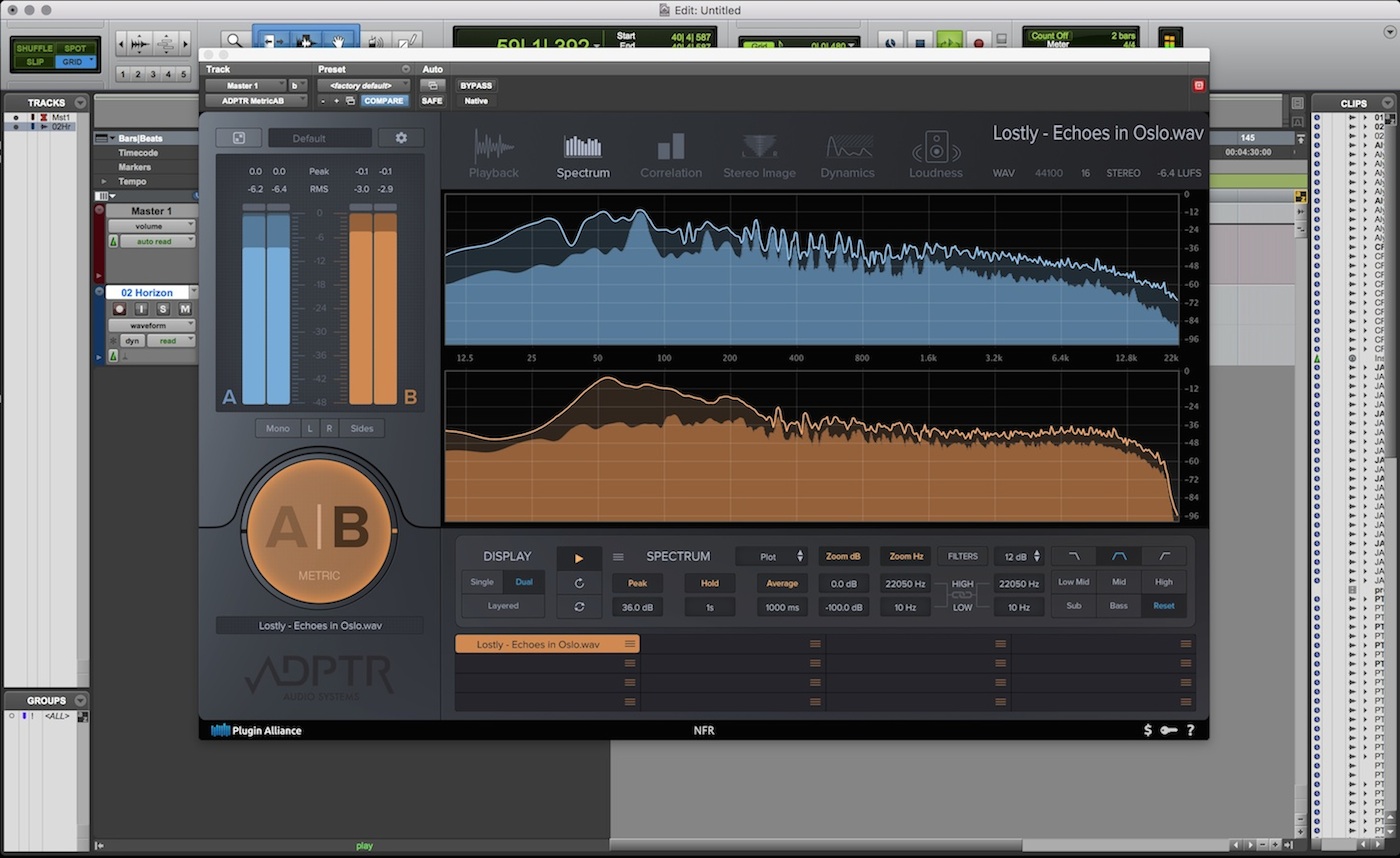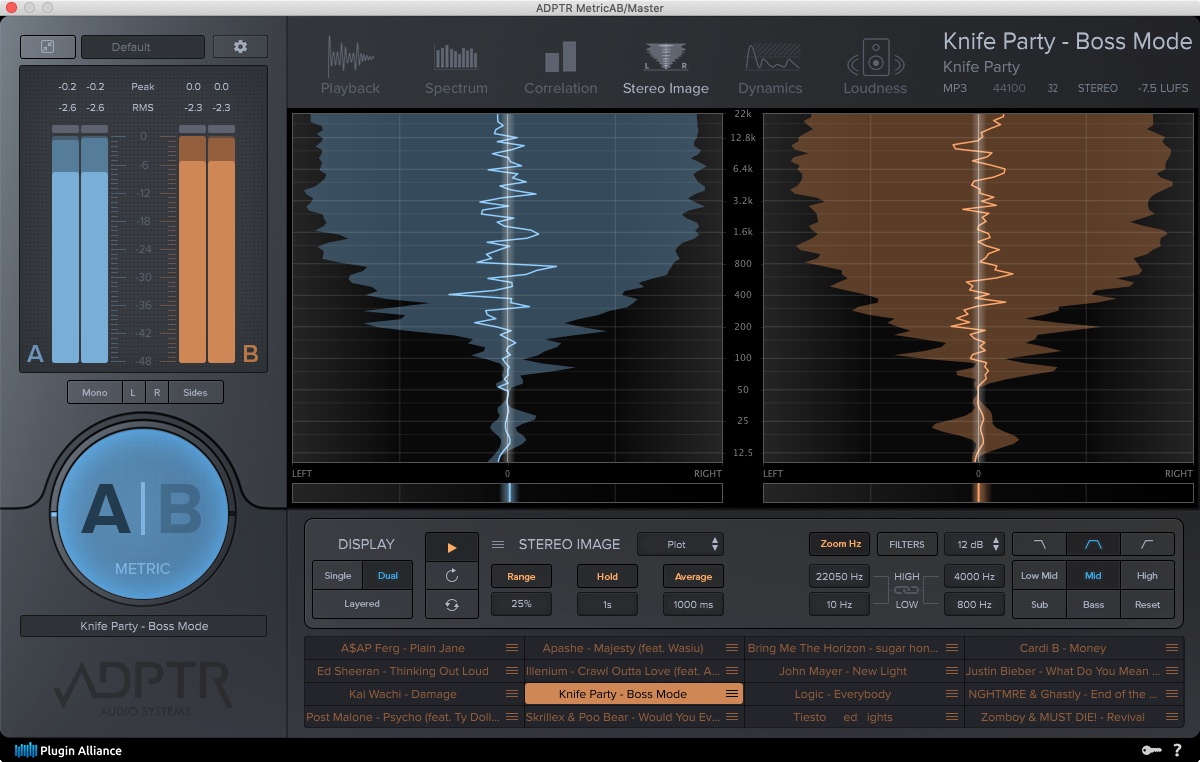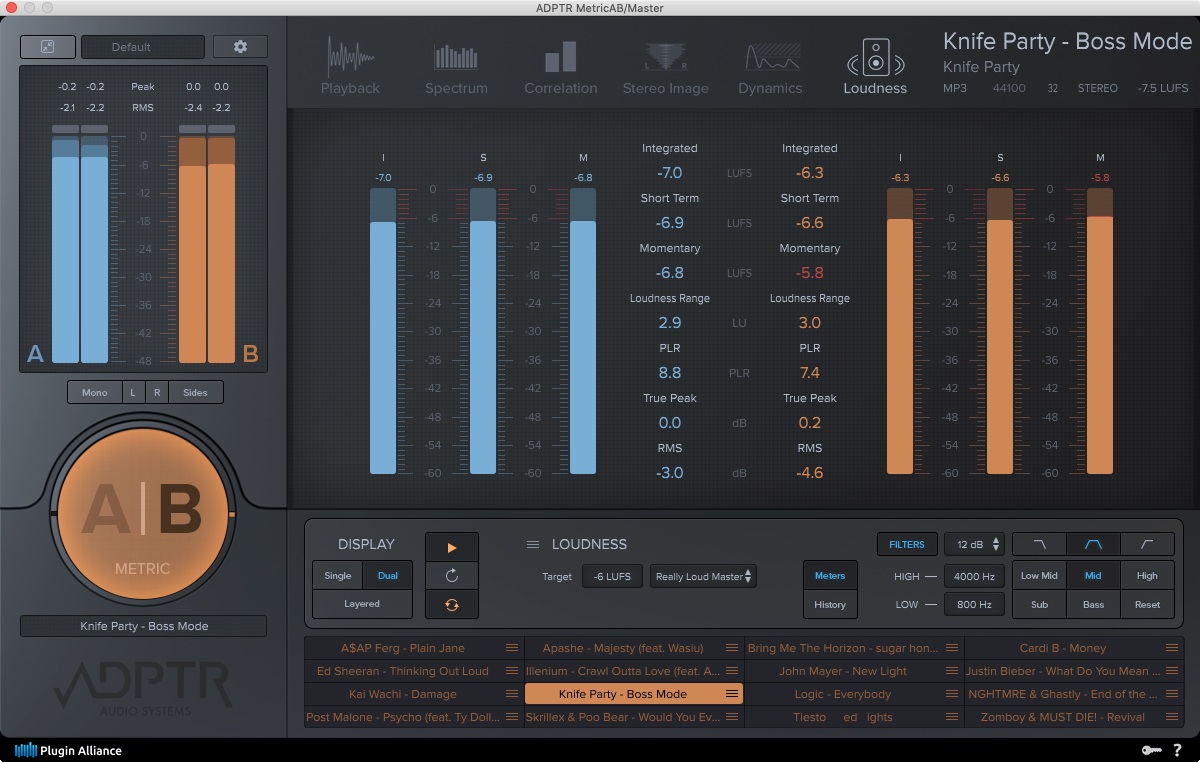New Software Review: MetricAB by ADPTR AUDIO

ADPTR AUDIO aims to deliver a powerful referencing solution via MetricAB—can it streamline your A/B process?
ADPTR AUDIO’s MetricAB plugin is a mixing and mastering tool that allows you to A/B your songs against other tracks, including commercial hits.
Distributed by Plugin Alliance, what makes MetricAB unique is the number of ways in which you can compare your song to other songs, and the ease-of-use features that it offers.
If you’ve been struggling to use reference tracks effectively, MetricAB may be the solution. Let’s look a little closer to see if this plugin can help you re-imagine how you cross-reference your own work.
Features
I went in expecting a pretty simple tool, and was surprised by the number of features that MetricAB provides. The basics of the interface include a peak and RMS meter to the left, along with buttons that allow you to solo the mono image, left channel, right channel, and sides image. But perhaps the most noticeable feature in MetricAB is the giant A/B button, which can be mapped to a MIDI controller, allowing you to quickly toggle between your mix (blue), and the track you’ve loaded into the plugin (orange).
Getting a reference track into MetricAB is quite easy. All you have to do is click on one of the little hamburger icons to the right of an empty track slot, and locate the reference file you’d like to use on your drive. You can also collapse the entire plugin into a compact mode that displays only the features we’ve covered thus far.
In MetricAB, you’re aslo able to toggle between different views like playback, spectrum, correlation, stereo image, dynamics, and loudness. The first view you’ll want to draw your attention to is the “playback” view. It provides a one-click loudness match button that allows for accurate A/B comparisons. There’s also a playback mode section that will enable you to set track cue points. Of the four provided playback modes (latch, cue, sync, and manual), I find that cue mode works most effectively; whenever you pause and then resume playback in your DAW, the play head within MetricAB jumps back to the cue point.
When you switch over to spectrum view, you’ll notice that you have access to a display section with the option to select either single, double, or layer mode. Single mode displays the frequency response of either your input signal or the reference track, dual mode displays the frequency response of both signals separate from one another, and layer mode displays the frequency response of the signals overlaid with one another.
Layer mode is one of the most robust features MetricAB has to offer, and it’s also available in the correlation, stereo image, dynamics, and loudness views. There are plenty of other mastering meters out there that can provide you with the same information as the meters in MetricAB, but very few of them are meant for A/B comparisons. It feels like almost every feature of MetricAB was developed with reference tracks in mind.
The spectrum analyzer allows you to toggle peak level measurements, edit peak ballistics, toggle a peak hold time function, and edit the ballistics of peak hold time. There are five graphs to choose from that include plot, octave, 3rd octave, critical, and multi. The critical graph is my go-to option since it allows you to compare essential frequency ranges between your input signal and reference track.
There’s a filter section that always remains visible, regardless of which view you’ve selected. It allows you to filter the sub, bass, low mids, mids, and highs of both your input signal and the reference track. You can change the low and high crossover points of each band, along with the slope of the filters. It’s also possible to solo all the bands below the currently selected band, or all the bands above it. The filter section offers a unique way to audition your mix against a reference track and pinpoint critical similarities and differences between the two.
Next up is the correlation view. It shows you phase correlation between the left and right channels across the entire frequency spectrum; this is a particularly unique feature that not many phase correlation meters posses. The benefit of this feature is that it should allow you to quickly identify the elements of your mix that are causing phase issues. Again, you’re able to check the phase correlation of your mix against a reference, and also view phase correlation over time by enabling the history button. There are controls to manipulate the ballistics of range measurements, and the ballistics of range hold time. Just like the spectrum view, you’re able to choose five different graph options.
The image to the right demonstrates the stereo image view in dual mode. You should now notice that controls are somewhat consistent across views, except for meter-specific functions.
The dynamics view reads out a PSR (Peak to Short-Term Loudness) value. Setting a target level of high dynamic, dynamic, competitive, loud, squashed, or crushed allows you to aim for a specific PSR value. There are controls to play/pause, restart, and cue the meter along with track playback. This view also displays the PSR value pre- or post-filters, which seems a bit excessive in my opinion. Having said this, MetricAB definitely leans towards a feature-rich interface, rather than a feature-scarce interface.
No mastering meter suite would be complete without a dynamic range metering view. MetricAB allows you to measure integrated, short term, momentary loudness, true-peak, RMS (Root Mean Square), and PLR (Peak to Loudness Ratio) values.
Setting a target loudness value is simple with the included preset menu. If your goal is to match the loudness of your reference track, just cycle through presets until you find one in which your reference track isn’t peaking into red values on its meter. From there, you can apply dynamic range reduction with a compressor of your choice to match the loudness of your reference track.
In Use
I don’t typically buy new plugins unless they’re going to offer some sort of workflow enhancement that will save me a significant amount of time, or provide a feature that I otherwise don’t have access to. MetricAB does both of these things and makes using reference tracks a breeze.
I work as a mastering engineer, and my clients send me a variety of different types of music to work on. With the sixteen reference track slots, I’m able to quickly pull up a reference track that makes sense for the genre at hand, which lets me get to work immediately. Due to this convenience, and the loudness matching feature, MetricAB has earned a permanent spot in my mastering project template.
On top of working exceptionally well with reference tracks, MetricAB is powerful enough to function as a dedicated general metering suite. If you could only afford one metering plugin, this would be a strong contender due to the sheer volume of functions and abilities that it provides.
While there’s no doubt that MetricAB is an absolute workhorse metering plugin, you may be wondering how it stacks up against its competitors. In my opinion, Insight 2 by iZotope is one of the gold standard metering suites that’s been released recently; being able to view multiple meters at once is quite a nice feature.
MetricAB may only provide access to one meter at a time, but it integrates with reference tracks, which is a massive feature that Insight 2 doesn’t offer. I think that once people start to experiment with MetricAB and realize its potential, it’s either going to take over the metering plugin market, or other plugin companies will begin to follow in its footsteps.
To Be Critical
I don’t have too many negative things to say about MetricAB. Initially, I stumbled upon this plugin on Plugin Alliance’s website and thought it seemed a little too good to be true. To my surprise, the interface was polished, well thought out, and the functionality of each meter exceeded my expectations.
Sixteen reference track slots might seem like a lot, but they fill up quickly. It would be nice if you had the option to assign a genre to each slot and be able to choose a track from a quickly accessible drop-down menu within each slot. In a future MetricAB build, this would be a great update.
Mastering aside, MetricAB could also be a potentially great tool while mixing, but finding well-mixed, unmastered reference tracks is a complete nightmare. If ADPTR AUDIO included an assortment of unmastered reference tracks with MetricAB, this would open up its functionality even more. Though MetricAB is first and foremost a great mastering tool, some functionality to help dial in your mixes would also be a welcome addition.
Summing it Up
ADPTR AUDIO struck gold with MetricAB. It’s a feature-rich metering plugin that makes mastering music with reference tracks very simple. This plugin has found its new home at the end of my default mastering chain, and so far it’s made a world of difference in the way that I work.
Priced at $199, MetricAB is quite comparable to other metering suites on the market. If you sign up for Plugin Alliance’s newsletter, you can probably pick it up for much cheaper than that. I managed to purchase MetricAB for only $39 during a sale; you can try the 14-day demo for free here and check it out for yourself.
Charles Hoffman is a Mixing and Mastering Engineer at Black Ghost Audio. After graduating from the University of Manitoba with an English degree, Charles completed his education at Icon Collective in Los Angeles, CA.
Please note: When you buy products through links on this page, we may earn an affiliate commission.









[…] Distributed by Plugin Alliance, what makes MetricAB unique is the number of ways in which you can compare your song to other songs, and the ease-of-use features Read more… […]